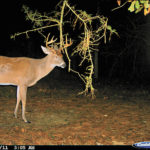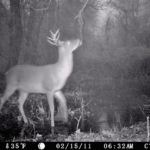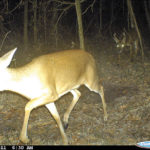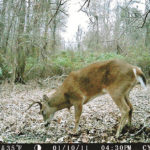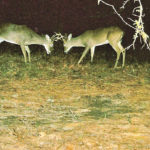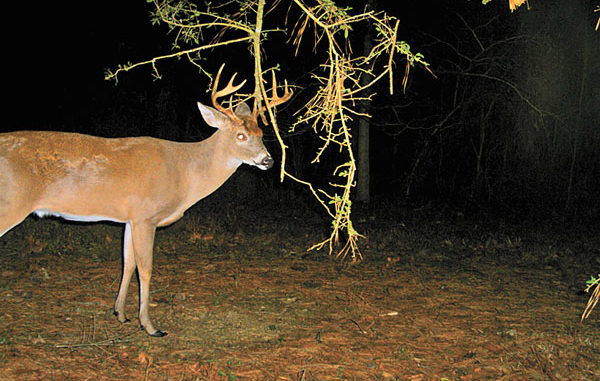
For the most part, the 2010-11 deer season is over, although I still have scrape cameras out in Pointe Coupee Parish (Upper Area 6), and no doubt will have photographs of antlered bucks on them during the middle of March and possibly into mid-April. It appeared that the late-rut prediction for the state was right-on target. In DeSoto Parish, Area 2, cameras documented bucks with antlers into early February. Generally in Area 2, by the end of December bucks are beginning to shed their antlers.
In the Clinton area, Area 1, where I hunt, the breeding began around mid December with the heaviest activity toward the end of the month. There was a lot of scraping activity in mid-December, and most hunters saw bucks chasing does toward the end of December.
On Dec. 29, I killed a low-end, 3½-year-old 8-point that weighed only 135 pounds. The buck had just finished working a couple of scrapes coming down a ridge to the creek where I was set-up.
The best buck activity I saw occurred during the month of January, which is the way it has been for the past four seasons. While December is the month when most of our breeding occurs, January seems to be the month when buck activity is the best. During December, when most of the does are ovulating, bucks do not have to move very far to find a hot doe. However, in January, the competition for the remainder of the does that have not bred is very keen, and the bucks are working hard to find them.
On Jan. 12, I passed on a nice 130-class buck, and on Jan. 19, saw this same buck again as it came out into a field looking for does. Also on the Jan. 19 hunt, I watched five racked bucks chasing a single doe.
If you’re one of those hunters who absolutely has to be out there during the early season and do not save any time for late-season hunts, you are really missing out on some good buck activity.
A trail camera photo I have, taken on Jan. 17, is proof that bucks are still active. And look at the classic photo of the buck standing in the scrape with its head in the overhead branches on Feb. 17. The deer season is over in Area 1, but the buck activity continues.
I also noticed that a lot of buck fawns have begun looking at scrapes, and will actually paw and urinate in them. Apparently their hormones are beginning to kick in.
Doe visits were also frequent in January, and I am not sure if these are does that have not bred or are just checking out the site. Does will also urinate and leave scent in the scrape as evidenced by the dark staining of their tarsal glands.
A change in DMAP proposed by LDWF for future seasons would enable clubs and landowners to take advantage of both late and early rutting activity by utilizing additional days of deer hunting. Both the buck and doe harvest is highly regulated with hunters using DMAP tags on both bucks and does that are killed on the property.
Such a program would be especially beneficial in the upper Area 6 and the Delta parishes of Area 1 where the serious rutting activity does not begin until January. Trail cameras indicate that the peak scraping in this area begins about the second week of January with breeding starting around Jan. 20.
The trail camera photo on Jan. 10 shows a buck getting a serious whiff of the scent that has been left on the ground in the scrape. The photo on Jan. 23 shows a doe passing through the scrape with a buck hot on her trail. If you believe that the breeding is done only by the big boys check out the rack on the buck.
The photo on Feb. 15 shows the same scrape from Jan. 10 covered with water, but the buck is still pawing in it and smelling the scent on the overhead branches. With the current hunting schedule for Area 6, gun hunters are missing out on some good buck activity, and this new DMAP proposal would be a way that would allow them to keep hunting the rut in February.
Turkey talk
On Jan. 26, I heard a tom gobble on the roost. Since I am writing this column in early March, the season has yet to open, so maybe next month I can share a turkey tale with you. It appears there is a good crop of turkeys for the 2011 season.
The Louisiana State Turkey Calling Contest was held at Bowie Outfitters in Baton Rouge on Feb. 26. A strong effort was made by the Louisiana Chapter of the National Wild Turkey Association to promote the contest and to energize interest around the state in the contest. There was a good turnout, and both the Open and Louisiana State Divisions had more than contestants competing for first place.
Judges for the contest included Jimmy Primos, Tucker Crisp, Jimmy Stafford, Danny LeBlanc and Jim Brown. Junior Beauvais fried turkey and Kristenwood Catering cooked a huge pot of jambalaya; needless to say, no one went away hungry.
Cy D’Aquila of New Roads won the Louisiana State Division, and will represent Louisiana at the national contest in Nashville. The Louisiana Chapter of NWTF will provide money for D’Aquila to make the trip to Tennessee. Dennis Neal of Baton Rouge won the Open Division, and Charles Clark of Delhi won the Amateur Division. The winners in the Jakes Division included Michael Lockhart, Hunter Neal and George Wood. Jason Thompson of Livingston won the Owling Division.
No doubt the treat of the day was 16-year-old Nikki Thompson of Livingston winning the Gobbling Division. The judges have no idea who is doing the calling during the contest, and I believe they were a little surprised when this young lady came up to receive her awards. Hopefully the state contest will continue to grow and attract more callers from around the state.
If you hunt turkeys and are not a member of NWTF, you should be. This organization has done much toward the restoration and management of this important game bird, but there is much more that could be done in Louisiana to enhance our turkey population and habitat.
